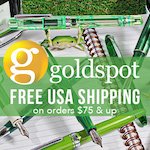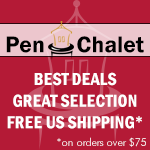(Susan M. Pigott is a fountain pen collector, pen and paperholic, photographer, and professor. You can find more from Susan on her blog Scribalishess.)
I've had my eye on the Aurora Sole (both the Optima and 88) for quite some time. In fact, I almost purchased the Optima Sole a few months ago, but couldn't decide between it and the 88. If I were to buy one, it probably would be the 88 simply because I like the shape of the pen, but the Optima Sole is just as beautiful and is certainly less expensive (if you can find one).
The Aurora 88 Sole is a limited edition of 888 pieces to celebrate Aurora's 70th anniversary of the 88 model. This limited edition pen comes with a high price tag, $895 retail, though most pen vendors sell it for a little less than that. It is currently $715 at Vanness Pens.
Made from marbled Auroloide (a cellulose acetate derivative), the pen looks as though it is lit from within. The material is absolutely stunning, especially in sunlight.
The cap finial, piston, and grip are made of black resin. The cap is encircled by Aurora's distinctive clip and a gold band inscribed with the Aurora name in cursive.
The limited edition number is engraved on the back of the cap near the finial in gold. This pen is number 242 out of 888.
Auroras come with a small ink window (about 5mm in width) that lets you keep track of how much ink is in the pen. But, if you run out, there's a reservoir with a bit more ink that will allow you to write one more page. Just unscrew the piston knob and keep writing. The piston works smoothly and draws in about 1.1ml of ink.
My favorite size nib in the Aurora line is the medium. It is smooth and stiff with just a hint of feedback typical of Aurora nibs. By "feedback" I don't mean "scratchy." Aurora nibs just have a tactile pull to them when you write. The scroll work on the nib is beautiful and that's one reason Aurora pens are among my favorite brands. Their nibs are still made in house and are outstanding.
The feed is made of ebonite and the nib size is imprinted on it.
The 88 is a cigar-style design well suited for most people. It's a medium-sized pen, measuring about 133mm capped, 128mm uncapped, and 155mm posted. Posting gives the pen more heft and length if you need that for comfortable writing. The 88 is slightly longer than the Optima, but when you compare them uncapped, the length from the tip of the nib through the grip is exactly the same. The difference in size is found in the length of the barrel.
The Aurora 88 is such a comfortable pen. The length and weight are perfect for my hand, and I love the raised lip design on the grip that keeps your fingers in place.
I think the Sole is one of the prettiest of all Aurora Auroloides. It is a bright marbled orange/yellow that simply glows. However, it should be noted that the Auroloide is translucent and the black portions of the pen show through. If you use a dark ink, that will show as well. I'm not bothered by the translucency, but some may think that the black showing through detracts from the beauty of the pen.
Pros
- The Aurora 88 Sole is a beautiful limited edition fountain pen. Collectors will definitely want to have a pristine model for their collections, but it's too good of a writer to keep behind glass.
- Aurora nibs are made in house and are exceptional both in design and performance.
- I think the medium nib is the best size of Aurora nib, though I like the broad as well. It writes smoothly with just a bit of feedback.
- The material on this pen is stunning. It is like carrying a ray of sunshine in your hand.
- Aurora knows good pen design, and the 88 is a classic. The size is a perfect fit for most hands, and it's a piston filler (one of the most popular filling methods).
Cons
- At $895 retail, the Aurora 88 Sole is very expensive. If you like the material but don't want to pay that much, you might be able to find a used Aurora Optima Sole for about half that price.
- Some people may find the feedback from Aurora nibs annoying. The nibs are also very stiff, so if you prefer nibs with a bit of spring, Aurora may not be the brand for you.
- Because the Auroloide is translucent, the black portions of the pen show through, and that might be a deal-breaker for some.
(Kenro Industries provided this product on loan to The Pen Addict for review purposes.)
Enjoy reading The Pen Addict? Then consider becoming a member to receive additional weekly content, giveaways, and discounts in The Pen Addict shop. Plus, you support me and the site directly, which I am very grateful for.
Membership starts at just $5/month, with a discounted annual option available. To find out more about membership click here and join us!
If BB8 had a fountain pen, it would be the Aurora 88 Sole.





























